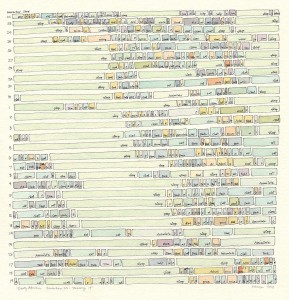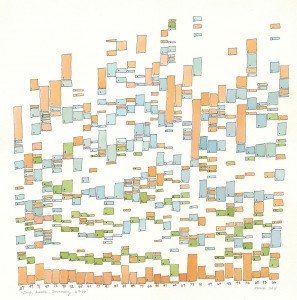The beginning of collecting personal data
/Almost four years ago I started collecting data. It began with daily timekeeping. Everywhere you looked, on the subway, sitting in restaurants, even walking down the street, we had become obsessed with constantly checking our phones. Described by the writer, Linda Stone as ‘continuous partial attention’ it felt like something had shifted in our daily routine, time felt more sliced and fragmented than ever. This deserved some study, and the best way to understand something is to measure it.

But keeping track of time, minute-by-minute is even harder than it sounds. After several amateurish attempts I googled methods to track daily time, and found Ben Lipkowitz. He had not only had been logging his time since 2005, he generously and fastidiously shared all of online at www.fennetic.net. Go take a look, it’s all still there. He stopped recording at the beginning of 2011, but the html files and graphics of page upon page of detailed time logs 24 hours a day for more than 5 years are all documented, annotated and available online. Rather than be totally intimidated by Ben Lipkowitz’s prodigious talent and relentless recordkeeping, I instantly snagged and downloaded all of his data and combed thru it for patterns. My theory that the rhythms of daily time are familiar and visually appealing held true.
Undeterred by the difficulty of tracking how you spend your time, I decided to focus on data gathering using gadgets that do all the work for you. Forget manual recording. Sensors would only get smaller, cheaper and more invisible over time. Maybe I could try to live just a little bit in the future and use myself as a test subject using sensors and devices that did the data collection with no effort on my part. And voila! My very next purchase in early 2010 was a Zeo sleep tracker. It was brilliant, all I had to do was strap the headband on and fall asleep. In the morning, I had minute by minute record of deep, REM, light and awake sleep states using a finely calibrated dry EEG sensor.
Sleep had always been described as 90 minute cycles, and I imagined sleep as big blocks of uninterrupted time. Turns out sleep is similar to waking hours, there is a definite pattern, with much more activity than you’d imagine. It’s ragged with shorter 5, 10, 15 minute bursts of deep sleep and REM sleep than I thought. I wake up a lot. My brain is pretty busy at night, evidently sleep rhythms are not so different than waking rhythms.




